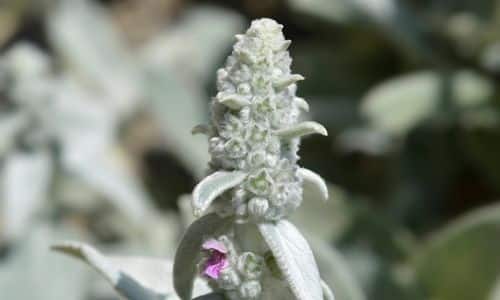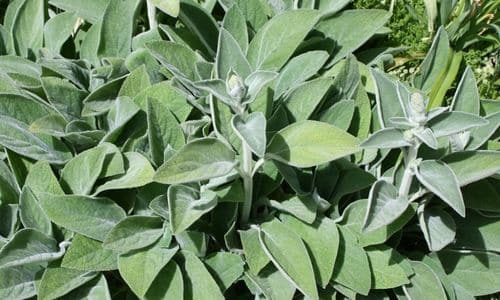Imagine touching a plant that feels like touching a Lamb’s wool. Stachys Byzantina, commonly known as Lamb’s Ear, is a hardy perennial which has a fuzzy, soft and velvety foliage that looks similar to a lamb’s ear.
It is a hardy perennial which is found mainly in the Middle Eastern and Mediterranean regions. It grows well in the U.S. hardiness zones of 4a to 8b. Some gardeners have grown lamb’s ear in different soil types by adopting proper drainage systems.
Being drought tolerant, it is a classic choice for rock gardens and gravel gardens. It is an ideal edging plant that looks attractive in the summer with its silvery white felted leaves and small lavender pink flowers.
In addition to its velvety leaves and eye catching blooms, it is also used as band aid for healing wounds and stings.
In this article, we will discuss about different aspects on How to Grow Lamb’s Ear that can last for years.
| Plant Name | Lamb’s Ear |
| Other Names | Wooly Betony, Big Ears |
| Preferred Zones | 4a to 8b |
| Bloom Period | Late Spring to Early Summer |
| Height & Spread | 12 inches tall x 12 to 18 inches wide |
| Soil Preference | Well-Drained Soil |
| Sunlight | Full Sun to Partial Shade |
| Flower | Pink |
| Native | Middle East, Iran, Turkey |
| Spacing Preference | 12 inches |
How to Grow Lamb’s Ear
1. Choose a location in your garden that receives full sun to partial shade and has well-draining soil. Lamb’s ear grow pretty well in alkaline soils. If the nature of soil is acidic, then you can mix it with lime during the planting time to get adequate growth for your plants.
2. Prepare the soil by adding compost or well-rotted manure to improve its fertility and structure.
3. Plant lamb’s ear seeds or young plants in the spring, spaced about 12 inches apart.
4. Water the plants regularly to keep the soil moist but not soggy.
5. Apply a balanced fertilizer once a month during the growing season to promote healthy growth and abundant blooms.
6. Deadhead the spent flowers to encourage continued blooming and prevent self-seeding.
7. Cut back the plants in late fall to remove any damaged or dead foliage.
8. Mulch the plants in the winter to protect them from extreme temperatures and keep the soil moist.
9. Divide the plants every few years to keep them healthy and prevent overcrowding.
Propagating Lamb’s Ear

Division: Lamb’s ear can be easily propagated by dividing the clumps of established plants in early spring or fall. Carefully dig up the plant and divide the clumps into smaller sections, each with at least one healthy leaf and root system. Plant the sections in well-draining soil in a sunny location and water regularly until they are established.
Stem Cuttings: Lamb’s ear can also be propagated by taking stem cuttings in late spring or early summer. Cut a healthy stem from the plant and remove the lower leaves. Dip the cutting in rooting hormone and plant it in a well-draining soil mix. Keep the soil moist and provide some shade until the cutting has rooted and new growth appears.
Seed: Lamb’s ear can also be grown from seed, although it may take longer for the plants to mature. Sow the seeds in a well-draining soil mix in early spring and keep the soil moist until the seeds germinate. Provide some shade until the seedlings are established and transplant them to a sunny location when they are large enough to handle.
Planting from root cuttings: Another way to propagate lamb’s ear is by planting root cuttings. Dig up the plant in early spring or fall and cut the roots into small sections, each with a healthy bud. Plant the root cuttings in a well-draining soil mix and water regularly until they are established.
To remove your confusion regarding the best option to propagate lamb’s ear plant. It is advisable to propagate the plant by division. The reason is simple: it is easy and more successful compared to other procedures.
Pruning

To prune lamb’s ear, follow these steps:
1. Wait until spring or early summer when the plant is actively growing in your garden. This is the best time to prune Lamb’s Ear as it will have plenty of time to recover and produce new growth.
2. Use clean, sharp scissors or pruning shears to remove dead, damaged, or diseased leaves and stems. This will help to improve the plant’s overall health and appearance.
3. Cut back the plant to the desired size and shape. Lamb’s Ear can be pruned quite aggressively without damaging the plant, so you can remove as much of the plant as you like.
4. Dispose of the pruned material and clean your pruning tools with rubbing alcohol or a disinfectant to prevent the spread of disease.
5. Water the plant well after pruning to help it recover and encourage new growth.
Note: Avoid pruning lamb’s Ear in late summer or fall, as this can stress the plant and make it more susceptible to damage from cold temperatures.
Best Cultivars to Choose
Silver Carpet

The leaves of silver carpet are covered in soft, silver-white hairs that give the plant a velvety texture and shimmer in the sunlight. This cultivar is known to be sterile that does not need deadheading. It is propagated by divisions.
Silver carpet blooms in late spring or early summer with small, pink, or purple flowers on tall spikes that attract bees and other pollinators.
Big Ears(Helen von Stein)

The characteristics of silver carpets and big ears are similar. Usually, southern gardeners prefer it due to its more tolerant nature of surviving in hot and humid conditions.
The wooly evergreen leaves of Helen von Stein are slightly longer and more slender than those of other lamb’s ear cultivars, giving the plant a more elegant appearance.
Cotton Boll
Unlike the other two cultivars mentioned above that don’t bear flowers. Cotton Ball has dense white flowers that unusually resemble cotton balls.
It grows well under hot conditions and requires special care during winters. It needs well-drained soil in full sun to grow well. It takes time to regrow, unlike other cultivars.
Cotton Balls can also survive under humid conditions. Still, one has to check the soil regularly because the plant becomes weak in excessively moist soil.
It is generally planted as a ground cover, just like other Lamb’s Ear cultivars.
Primrose Heron
This beautiful cultivar has adorable light silver-green leaves and pink flowers atop stems that look fantastic when planted on the edge of pathways.
Like the other cultivars mentioned above, Primrose Heron grows well under hot and dry conditions requiring full to partial sunlight.
Also Read: Lamb’s Ear vs Mullein: Which is Better for Your Garden?
Common Problems Affecting Lamb’s Ear Growth
Lamb’s Ear is a tough, hardy perennial plant without complete care to flourish. It is not highly susceptible to diseases and pests. However, high moisture conditions can invite pests and other diseases to stop plant growth.
Pests & Diseases
Slugs and Snails: These pests are attracted to the soft, succulent leaves of lamb’s Ear and can cause significant damage if left unchecked. They are most active at night and can be controlled by using slug and snail bait or setting traps.
Powdery Mildew: Powdery mildew is a fungal disease characterized by a white or gray powdery growth on the leaves and stems of lamb’s Ear. It is most common in damp, humid conditions and can be controlled by providing adequate air circulation, avoiding overhead watering, and treating the plant with a fungicide.
Root Rot: Root rot is caused by over-watering or poor drainage. It causes the roots of the Lamb’s Ear to rot and become soft and mushy, leading to yellowing and wilting of the plant. Make sure to stop the surge of rot from reaching the rest of the plant. It can be controlled by improving drainage and avoiding over-watering.
Rust: Rust is a fungal disease characterized by orange, yellow, or reddish-brown spots on the leaves of lamb’s Ear. It is most common in wet, humid conditions and can be controlled by providing adequate air circulation, avoiding overhead watering, and treating the plant with a fungicide.
Verticillium Wilt: Verticillium wilt is a fungal disease caused by the fungus Verticillium. It causes the leaves of the lamb’s Ear to turn yellow and wilt, eventually leading to the death of the plant. It can be controlled by providing good drainage, avoiding over-watering, and treating the plant with a fungicide.




